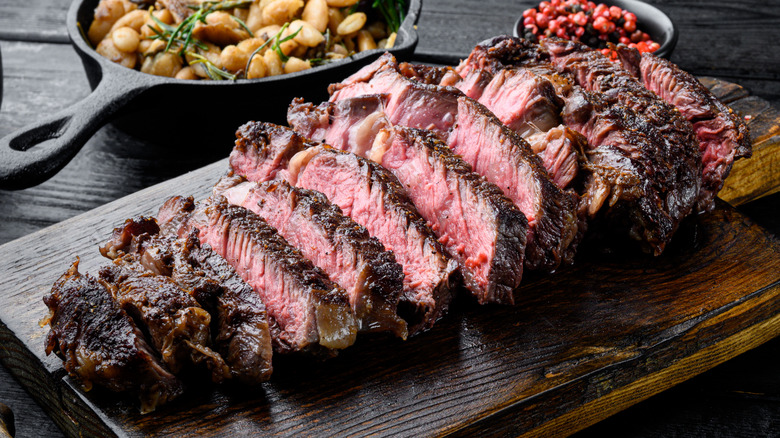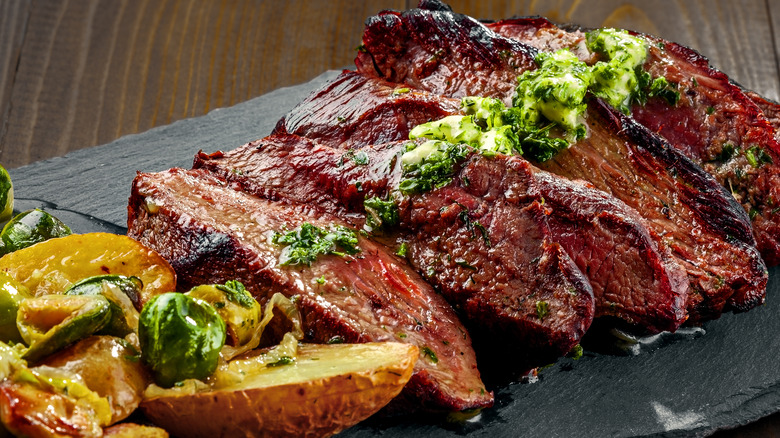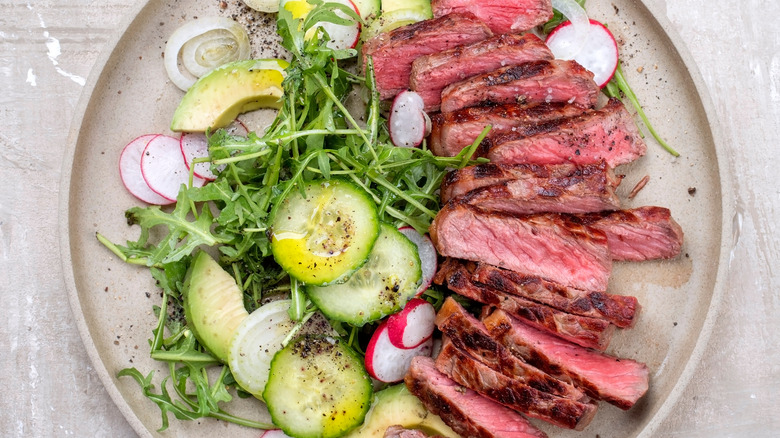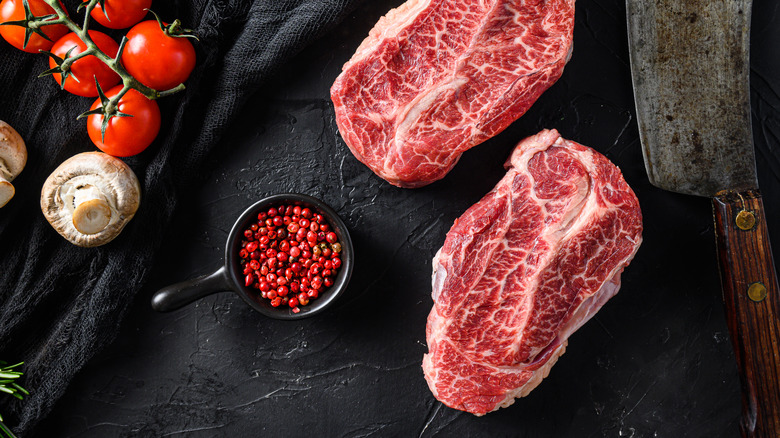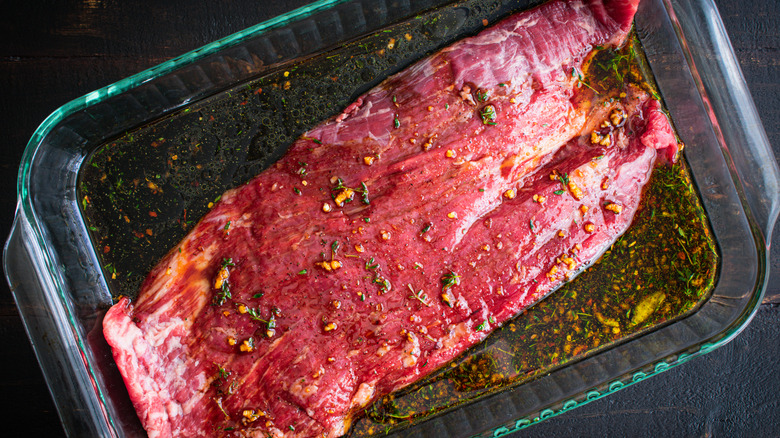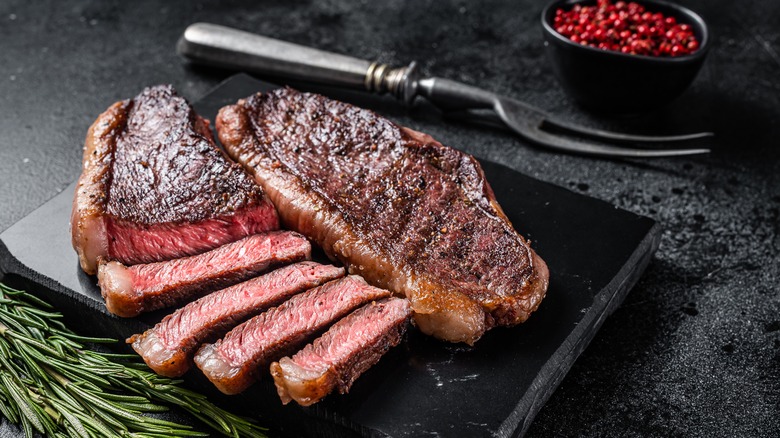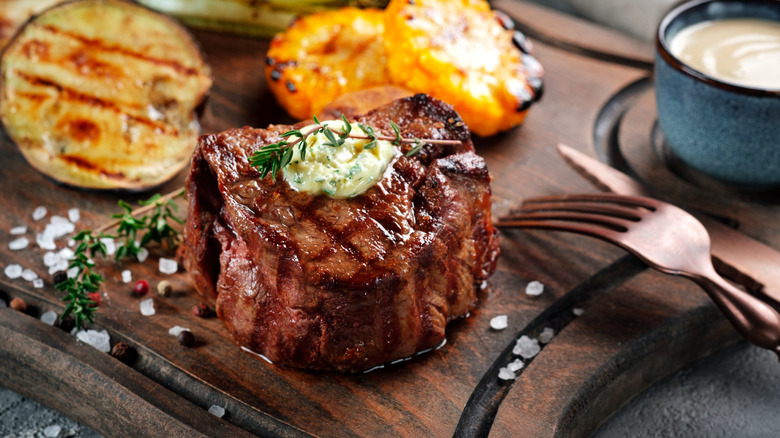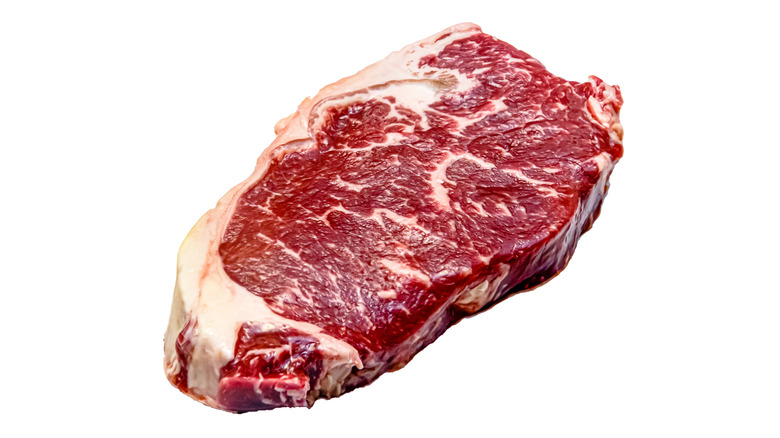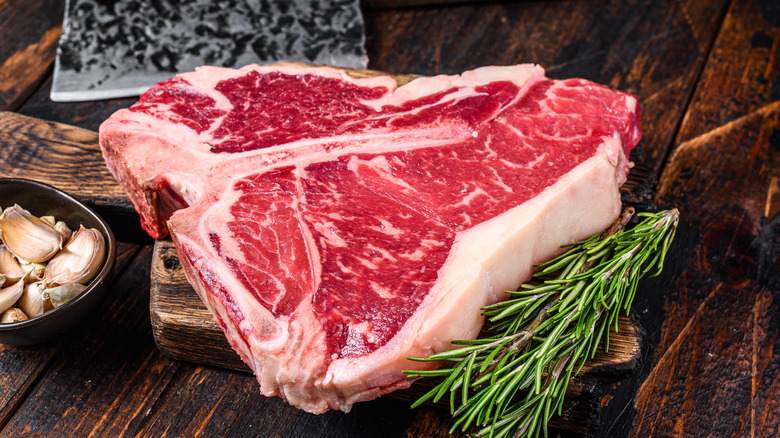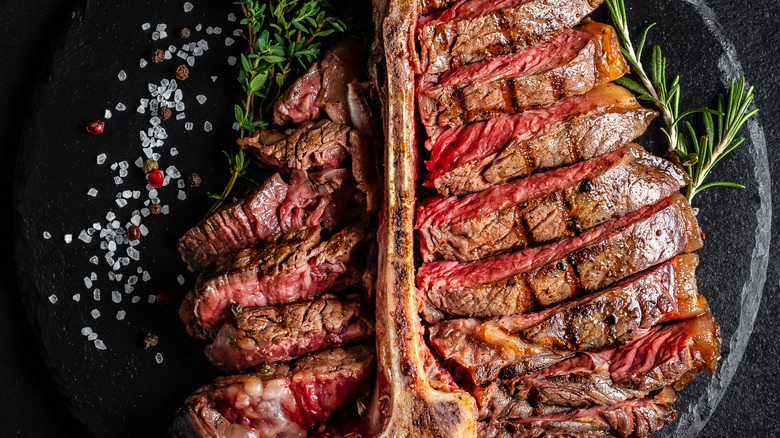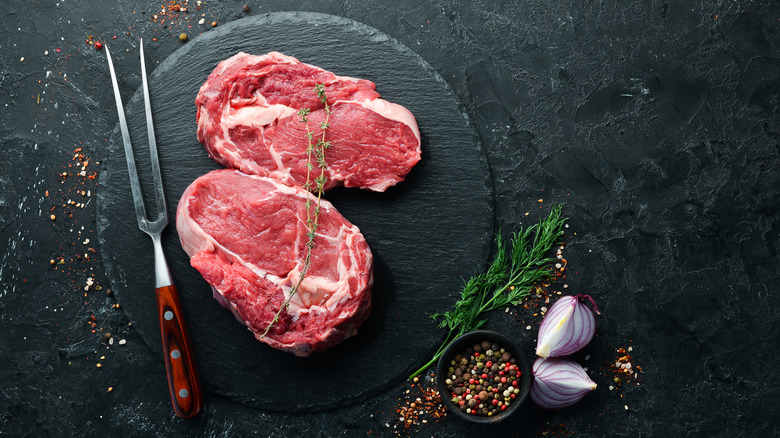Ranking 10 Cuts Of Steak To Grill From Worst To Best
If beef is on the menu for your next barbecue, it's easy to get overwhelmed by the sheer number of different steaks on offer at the grocery store. After all, cows are enormous and there are so many cuts available, be they steaks, roasts, ribs, or brisket. Although beef from any part of the cow tastes like beef, it makes sense that each cut of meat has qualities that are best suited for specific recipes.
In brief, the meat from well-muscled areas needs different treatment than cuts from unworked muscles that give buttery, marbled steaks. That's why beef shanks (from the lower legs) are braised for hours and why ground beef comes from the round, which is the upper thigh and back end (via The Prairie Homestead). These cuts would be unpleasantly gristly and tough if you tried to cook them as you would pricier and more tender filet mignon.
While you might be used to heading right for the London broil and calling it a day, there's good cause to try different cuts of steak on the grill. Consider factors like the recipe you want to make, the number of people at the table, and your budget. All these and more will play a role in helping you pick the right cut of steak you need for any meal.
Let's explore some of the most popular cuts of steak to grill, ranked from worst to best. Once you become an expert with this info, your barbecues will be golden.
10. Hanger steaks
Although hanger steaks are often compared to flank and skirt steaks, hanger steaks have the edge over the other two. Flank and skirt steaks come from well-worked muscles on the cow (the abdominal muscle and the diaphragm). Meanwhile, the hanger steak is also known as the "hanging tenderloin" because it is a supporting muscle between the ribs and the loin. It is tender and has more marbling than flank or skirt steak, which gives it great flavor and juiciness.
Hanger steak can handle a marinade, but simple seasonings also bring out the meat's flavor. To that end, GrillGirl says that a quality hanger steak doesn't need a marinade. If you want to keep things simple, you can simply brush the steak with olive oil, then season it with a sprinkle of salt and pepper. You can't go wrong with hanger steak, though, so season with your heart if you want some more complexity.
Such glowing remarks might make you wonder why hanger steak ranks so low on our list of steaks for the grill. First, it's not terribly accessible. Grocery stores rarely sell hanger steaks because there's only one per cow. What's more, Bon Appétit ranked beef as the least-sustainable meat, given that cows require vast amounts of land, water, and feed. Perhaps beef should be a delicacy, not an everyday meal. With that in mind, serving hanger steaks only occasionally is a better choice for sustainability.
9. Skirt steak
Skirt and flank steaks are often confused, especially since they work almost interchangeably in many of the same recipes. While both are lean, well-muscled cuts that typically need a good marinade to avoid the dreaded leathery chew, as per The Kitchn, they have some significant differences. Flank steak is from the abdominal area of the cow. Skirt steak, hailing from the diaphragm, has a deeper, more profound flavor than flank. Both cuts must, if grilled, be cooked quickly over a high flame. Overcooking skirt steak is hopefully a mistake you'll likely make only once, though it's frustratingly easy to do with a grill and a minute of distraction.
In the mood for Mexican food? Carne asada is used in tacos, burritos, enchiladas, and fajitas. Leftover skirt steak? No problem! It makes a beautiful sandwich or main dish salad. Skirt steaks are tasty on their own, but because they stand up to spices and marinades, the world is your oyster.
If you're using a charcoal grill, consider making the fire on one side of the grill for a cool zone, allowing the meat to finish cooking after searing. Like all cuts, resting the steak redistributes juices throughout for unmatched tenderness. Although there might be grumbles while the steak rests, remember that it's worth waiting.
8. Flat iron steak
A flat iron steak comes from the shoulder of the cow, where silver skin connects it to the top blade steak. The flat iron forms a thick rectangle with the skin removed and is well-marbled, making it rich and succulent. It holds up well to marinades and seasonings, which is lucky. Since the shoulder muscle works hard, flat iron steak needs quite a bit of tenderizing (via Taste of Home).
Flat iron steaks cook splendidly on the grill because doing so over high heat renders the fat, basting the steak and ensuring mouthwatering flavor. Grilling also allows the meat to cook quickly, lessening the chances of tough, chewy steak. It's ideal to avoid cooking a flat iron steak past medium — medium-rare is preferable for keeping the meat tender and juicy. That requires some attention that might be tough during your standard cookout.
Marinades expand flat iron steak's versatility, allowing it to absorb the flavors of various cuisines. Flat iron steak is used in main dish salads, tacos, sandwiches, kabobs, stir fry, or an old-fashioned meat and potatoes meal. As with every steak, it's best to let it rest for up to 10 minutes before slicing thinly across the grain.
7. Flank steak
Flank steak is often confused with skirt and hanger steaks. Like real estate, location distinguishes one from the other. According to Butcher Magazine, flank steak comes from the abdominal muscles, skirt steaks from the diaphragm, and hanger steaks hang near the diaphragm and kidneys. Flank steak has no marbling and needs tenderizing with a meat mallet or acidic marinade (think citrus, vinegar, or wine-based) before cooking; otherwise, the meat will be tough. A bit of extra effort ensures tender, delicious meat.
Men's Health touts this as one of the healthiest cuts of beef, with one standard cut containing 24 grams of protein, 6 grams of fat, and just 162 calories in a 3-ounce serving. Even considering most people will eat more than that, a lean flank steak fits easily into a healthy diet. Flank is a relative bargain, too, because prized cuts (that is, the tenderest ones) come from underused muscles like the loin, as per Bon Appétit.
Grilling is a superb way to cook flank steak. Be vigilant, however, as overcooking makes it almost impossible to chew. And, yes, it may not be as luxurious as a fattier cut will taste. A few minutes per side on a hot grill brings out the flavor, but never cook flank steak past medium. Anyone that doesn't like steak pink and juicy should choose a different cut. Flank is versatile and holds up to spices, so it's ideal for fajitas, Mongolian beef, or a spicy satay.
6. Top sirloin
Top sirloin is familiar to most because it's reasonably priced and easy to find in your local store. However, it's not considered one of the best steaks because it's a well-worked muscle near the cow's back legs. While its flavor is good and there is decent fat marbling, it needs extra attention to avoid turning out tough and chewy.
Food Network reports that sirloin contains two sections: the top sirloin becomes boneless steaks, while the bottom sirloin, also called tri-tip, is best roasted. When grilling top sirloin, marinating will ensure a tender result, softening tough fibers while boosting flavor. A good marinade should always include an acidic ingredient, such as vinegar, wine, or citrus. Adding oil, garlic, spices, or liquids like soy, Worcestershire, or hot sauces adds even more flavor.
Like other well-muscled cuts, it's crucial to make sure a top sirloin isn't overcooked. Medium-rare (or at the very most, medium) brings the ideal result when grilling. Start with three minutes per side, then test the steak for doneness, either with a meat thermometer (the internal temperature should be 130 -140 F before resting) or, if you're an experienced griller, you can judge doneness by carefully pressing your finger into the steak. Steak University has a helpful tip: put your middle finger to the thumb of the same hand, then touch the pad of your thumb with the index finger of the other hand. If the steak feels like that, rest assured the meat is medium-rare.
5. Filet mignon
Whether served as filet mignon or Châteaubriand, the tenderloin is taken from beneath the cow's ribs in a long asymmetrical section that is thicker at one end. The entire cut is known as the tenderloin. To get more specific, filet mignon steaks come from the narrower end of this cut. Châteaubriand uses the thicker end (while it's not our focus here, that cut is delicious when roasted and seared with butter, garlic, and black pepper).
While many of the best steaks taste incredible because of their fat marbling, filet mignon is leaner with fine marbling, making it meltingly soft. It has a subtler, less beefy flavor that's easy to enhance with seasonings and sauces (via The Pioneer Woman).
So why doesn't filet mignon rank as the best steak on our list? According to chef Michael Ollier, pan-searing is the gold standard for these elegant steaks. Searing them ensures a gorgeous crust on every edge and allows you to deglaze the pan with wine, butter, or cream to create sauces that elevate your filet to the sublime. Grilling just can't help you get the best out of your pricey filet mignon.
If you're using another method, like pan-searing and finishing in the oven, following tips like using a meat thermometer, a two-zone fire, and twine to retain its classic round shape and preserve the juices to produce a fantastic filet.
4. Strip steak
Strip steak, also known as New York strip steak, comes from the short loin and is a tender, marbled cut. Strip steaks are often sold boneless; with the bone intact, it may be called a club steak. The term club steak might have been coined from exclusive clubs serving them, while others think it's because the bone looks like a club (via Sun Sentinel). This bone is L-shaped, but with the tenderloin attached it would be recognizable as a T-bone or porterhouse steak, depending on its thickness.
The outer edge has a rind of fat that gives the meat plenty of flavor and a lush mouthfeel. This fat bastes the steak while grilling, keeping it juicy in what can be a pretty harsh cooking environment. The Kitchn maintains that strip steaks need nothing more than a sprinkling of salt applied at least two hours in advance for a gorgeous crust and luscious interior. You can then grace the cooked steak with a pat of butter while it's resting.
Some say that using tongs rather than a fork to turn steak will help the juices stay inside more readily. Also, to get perfect results, remember to factor resting time into cooking since meat of any cut always cooks more after coming off the grill. Using a meat thermometer, remember to remove it from the flame about five degrees under temperature, since even five degrees can be the difference between ideal and an unwanted jaw workout.
3. T-bone steak
T-bone steak is recognizable for its namesake T-shaped bone connecting what are two fantastic steaks: the strip and the tenderloin. The strip side has more marbled fat, while the filet side is prized for its tenderness and buttery taste. The T-bone could be confused with a porterhouse steak since the only real difference between the two is their size. Rest assured, a T-bone will never disappoint you as long as you take care to cook it properly.
That said, grilling a T-bone can be tricky because the tenderloin side is leaner and cooks faster. Creating a two-zone fire can help, allowing the strip steak to finish cooking before the filet side gets overdone. Look for a T-bone where the tenderloin is as close in size to the strip side as possible, and choose one with good marbling, which will render down and help to baste the filet while it's on the grill.
Simple seasoning is all you need for a T-bone, and cooking fast over high heat will give the final result a great crust with a delectable beefy flavor. Steak Figures notes that the meat where the bone bends will cook slowest and will be most rare. However, since the average T-bone weighs between one and two pounds, an array of meat from rare to medium is likely to please everyone at the table. So long as you've got the attention and enough people, this could be a good grilling choice for your next cookout.
2. Porterhouse steak
The porterhouse combines two of the more heavenly steaks on our list: the filet mignon and the strip steak. It deserves a place of its own, however, since its heft qualifies it as a family-sized cut. If you've ever been confused between the T-bone and porterhouse (they admittedly look quite the same), note that the porterhouse is thicker and has more tenderloin attached to the cut than a T-bone steak.
Cut from the short loin, a porterhouse has plenty of fat marbling and is always sold bone-in. This cut doesn't really need to marinate because it is already excellently tender. A very light rub with olive oil and a sprinkling of salt and pepper is all that's needed. However, garlic, fresh herbs, and a pat of butter for finishing can certainly elevate the porterhouse to next-level deliciousness.
The Kitchn notes that a two-zone grilling method is best so the filet side doesn't overcook while the strip side finishes. Remember to keep your eye on the grill, too. Porterhouse can reach the ideal medium-rare doneness at just three minutes per side with a 10-minute rest, according to MasterClass. Adjust the timing according to the thickness of your steak and the level of doneness desired. If you want to serve the steak traditionally, thinly slice against the grain and arrange the slices next to the bone for extra visual appeal.
1. Ribeye steak
Ribeyes are exquisite steaks that are frankly well worth the price tag. Cut from the rib near the backbone, these steaks are well-marbled throughout. This makes the cut's flavor outstanding and ensures rich, juicy meat that's simple to prepare. Their size makes them ideal for a group, and since they're sold bone-in and boneless, they suit any recipe. What more could you want when it comes to grilling meat?
All the marbling present in a ribeye means that marinades aren't necessary. With that in mind, Taste of Home recommends a bit of salt and pepper sprinkled onto the cut before it hits the grill, with just a few minutes per side. Ribeyes are so flavorful that the taste of the meat really is enough on its own. Though some people prepare ribeyes in a skillet, grilling triggers what's known as the Maillard reaction, a breakdown of proteins and reactions between sugars and amino acids that form that much-desired and utterly delicious crust on a well-cooked steak.
If you're looking for a first-rate steak to grill this season, the ribeye will make your tastebuds sing. Even better, the ease of preparation will allow a celebration-worthy dinner on any night of the week.
